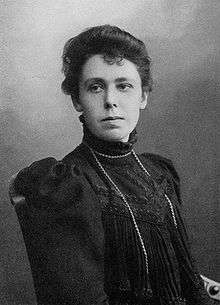Margarete von Wrangell

Margarethe Mathilde von Wrangell, after 1928 Princess Andronikow, née Baroness von Wrangell (7 January 1877 in Moscow – 21 March 1932 in Hohenheim) was a Baltic German agricultural chemist and the first female full professor at a German university.[1]
Studies and early professional years
Margarete von Wrangell originated from the old Baltic German noble house of Wrangel. She spent her childhood in Moscow, Ufa and Reval (today Tallinn). She attended a German girls’ school in Tallinn. After passing the teachers' qualifying examination with honours in 1894, she gave private lessons in science for several years. She also occupied herself in painting and writing short stories. Attending a botany course at University of Greifswald in 1903 became a turning point in her life. As of spring 1904, she studied Natural Sciences in Leipzig and Tübingen and, in 1909, received her PhD in chemistry from the University of Tübingen summa cum laude. The topic of her dissertation was 'Isomerism of Formyl-glutaconic Acid ester and its bromine derivatives'.
This was followed by years of further scientific study and travel. In 1909, she worked as an assistant at the Agricultural Experimental Station in Dorpat; in 1910, she participated in the work of William Ramsay in London in the field of radiation; in 1911, she became an assistant at the Institute of Inorganic and Physical Chemistry in Strasbourg; and in 1912, she worked for several months with Marie Curie in Paris. At the end of 1912, she became head of the Estonian Agricultural Experimental Station of the Agricultural Association in Reval. Her main task was overseeing seed, feeds and fertilizers. In the course of the Russian October Revolution, her institute was closed; she was arrested, but managed to flee to Germany in 1918.
Research
Beginning in summer 1918, von Wrangell worked at the Agricultural Research Station in Hohenheim, from 1920 on as a department leader. Her first scientific experiments focussed on the behaviour of phosphorus in the soil. In 1920 she completed her Habilitation at the Agricultural University of Hohenheim with a dissertation on Uptake of Phosphoric Acid and Soil Reactions. In 1923, she was appointed a full professor in Plant Nutrition at Hohenheim. With financial support from the government, she was awarded her own Institute for Plant Nutrition, endowed with laboratories and an experimental field. She headed this institute until her death in 1932.
Aftermath
Outside professional circles, Margarete von Wrangell’s life and scientific work was known especially through her biography, published after her death and entitled Margarethe von Wrangell. A woman's life from 1876 to 1932. From diaries, letters and memories represented by Prince Vladimir Andronikov. The book was first published in 1935 and went through several editions.
In the Federal Republic of Germany, Margarete von Wrangell was first 'rediscovered' by feminists. Her extraordinary life has made her a central figure in modern women's and Gender Studies. Since 1970, numerous publications have examined aspects of her life and social environment. Within agricultural historical gender research, she has long been among the outstanding pioneers of agriculture.
Two government funding bodies were named after her: In 1992, the government of North Rhine-Westphalia created the Foundation Margarethe von Wrangell, which promotes collaboration between universities and the SME sector;[2] and in 1997, the Ministry of Science Baden-Württemberg launched the Margarete von Wrangell Habilitation Program for Women, which promotes the habilitation of qualified women scientists.[3]
Selected publications
- Phosphorsäureaufnahme und Bodenreaktion. Verlagsbuchhandlung Paul Parey Berlin 1920. Habilitationsschrift Landwirtschaftliche Hochschule zu Hohenheim 1920.
- Gesetzmäßigkeiten bei der Phosphorsäureernährung der Pflanze. Verlagsbuchhandlung Paul Parey Berlin 1922.
- (Ed.) Die Düngerlehre. Von D. N. Prjanischnikow. Professor an der Landwirtschaftlichen Hochschule in Moskau. Nach der fünften russischen Auflage herausgegeben von M. von Wrangell. Verlagsbuchhandlung Paul Parey Berlin 1923.
- "Ernährung und Düngung der Pflanzen. In: Handbuch der Landwirtschaft. Herausgegeben von F. Aereboe, J. Hansen und Th. Roemer. Verlagsbuchhandlung Paul Parey Berlin 1929. Volume 2, pp. 295–396.
See also
Notes and references
- ↑ Weeks, Mary Elvira (1938). "Margarethe von Wrangell: Das Leben einer Frau, 1876-1932 (Andronikow, Prince Wladimir)". J. Chem. Educ. 15 (6): 298–299. doi:10.1021/ed015p298.2.
- ↑ Margarethe von Wrangell-Stiftung eV
- ↑ Margarete von Wrangell Habilitation Program for Women
Further reading
- Mayer, Adolf (1932). "Margarete von Wrangell, Fürstin Andronikof. ? 31. März 1932 zu Stuttgart". Die Naturwissenschaften. 20: 322. doi:10.1007/BF01504626.
- Schwarzl, Sonja M.; Wunderlich, Wiebke (2001). "Zum Beispiel: Margarete von Wrangell". Nachrichten aus der Chemie. 49: 824. doi:10.1002/nadc.20010490628.
- Naujoks, E.; Du Prez, FE; Espeel, P; Hawker, CJ; Junkers, T; Schlaad, H; Van Camp, W (1937). "Margarethe von Wrangell. Das Leben einer Frau. 1876-1932. Aus Tagebüchern, Briefen und Erinnerungen dargestellt von Fürst Wladimir Andronikow. 383 S. Mit 17 Bildern. Verlag Albert Langen/Georg Müller, München 1935. Preis geb. RM. 8,50". Angewandte Chemie. 50 (1): 60. doi:10.1002/ange.19370500120.
